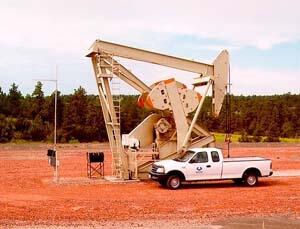
The AEPOC surface dynamometer card often shows problems before the equipment fails. Early warning allows operators to proactively work on equipment, preventing major breakdowns. Early detection of equipment malfunction saves repair costs and prevents downtime.
The AEPOC surface dynamometer card often shows problems before the equipment fails. Early warning allows operators to proactively work on equipment, preventing major breakdowns.

In the example shown, an impending equipment malfunction is indicated on the surface dynamometer card by the "spiral" near bottom of stroke (very left edge of card shown below). The customer's Theta Enterprises Host (XSPOC) program clearly showed this symptom on cards displayed on the office computer.
The position input used by this customer was an inclinometer. The position input indicated a significant shaking at bottom of stroke, even though no disturbance could be felt at the polished rod. The enhanced geometry unit (similar to unit shown above) vibration was magnified at the top side of the pumping unit away from the wellhead (near where the inclinometer mounts). Enhanced geometry pumping units tend to show structural vibrations near the top back of the unit due to their geometry. The automation technician was able to alert maintenance. They identified intermediate & bull gear problems before extensive damage caused expensive repairs.
The AEPOC can use a variety of position, load, analog and digital inputs. Preset site configurations and library loads provide easy setup. Full documentation helps customers configure special applications.
A&E RPC surface dynamometer cards retain crucial force vector information, showing polished rod speed and pumping unit acceleration. Enhanced charting or database applications can receive AEPOC data through the A&E EZ Viewer local user interface program, or remote host systems.